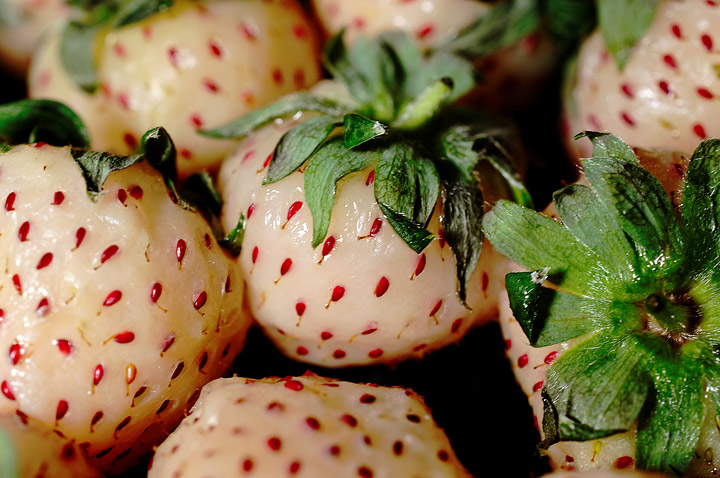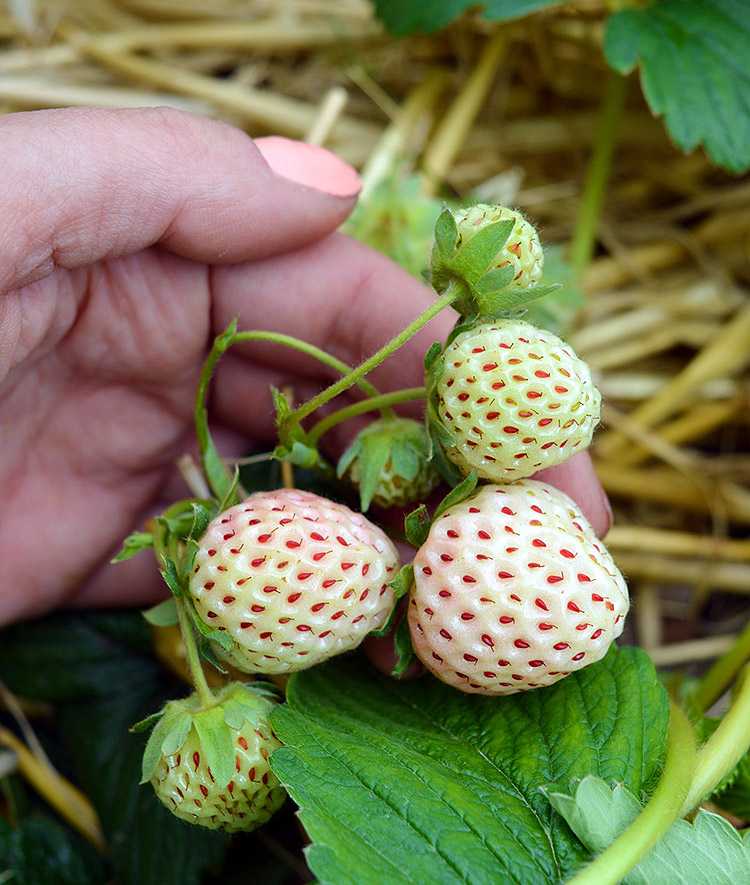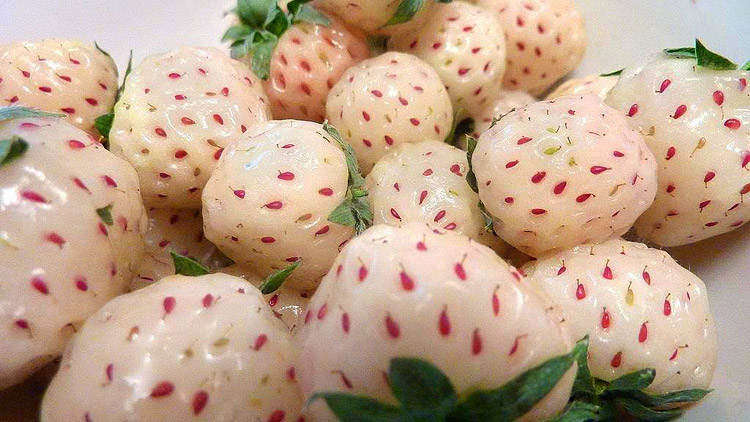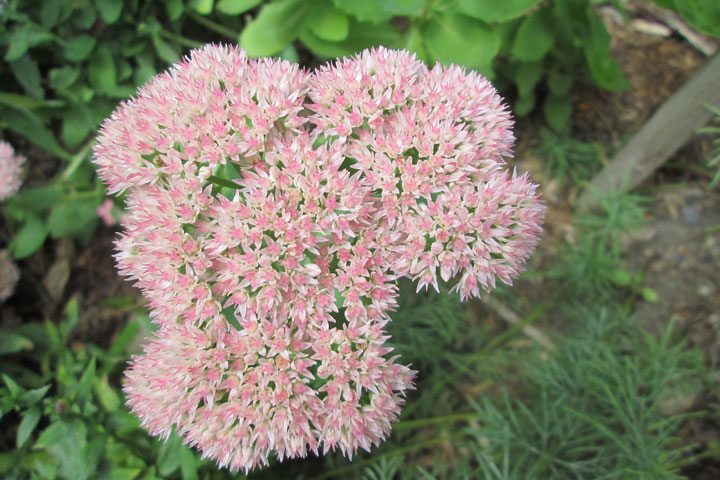
Pineberries are strawberries, but the name comes from their pineapple favor. They have white flesh and red seeds, just the opposite of regular strawberries. Pineberries may be a novelty now, but they are actually just an improved version of the original South American strawberry, reintroduced into the market highlighting their pineapple flavor. To those who are wary of GMOs: neither the color nor the flavor comes from genetic modification. Fragaria chiloensis, the South American strawberries native to Chile, were always white with just a touch of the lightest pink.
Pineberries, Fragaria x ananassa, are special in that they grow much in the way that ordinary red strawberries do except they produce small white berries instead of red. The also have a bit of a citrusy flavor and so live up to their reputation of tasting a bit like pineapple.
If you’re convinced to try growing them you’ll need to begin with bare-root plants or even better, plants created from runners. Like strawberry plants, freely throw out runners and establish baby plants in the soil all around them. These baby plants are essentially clones of the parent plant.
A note on any Pineberry seeds you see for sale – DO NOT buy them! Pineberries cannot be grown true from their seeds because they’re a hybrid.
How To Grow Pineberries
If you have experience growing regular strawberries, pineberry cultivation can be just as easy. However, getting the starts may not be. Many breeders offer branded plants, but there are mainly three varieties to look for: ‘White D,’ ‘White Carolina’ and ‘White Pineberry.’ White D has larger berries compared to the other two, but they are still smaller than your standard red strawberries. They are all more like Alpine strawberries in their growth habits and have their everbearing nature too.
Pineberry starts are priced high, but you have no other option since they may not come true from seeds as many gardeners have found out to their disappointment. You can perhaps buy just 2 or 3 now, and increase your stock by division. Make sure the plants you order are self-pollinating. Cross pollination with regular strawberries will not change the color or flavor of pineberries, and may, in fact, increase fruit set.
The pineberry starts you get by mail may be quite small and fragile-looking. They are suitable for growing in USDA zones 4-8, but you may have some success in other zones if they are grown in containers and protected from extremes of temperature. Ease them out of the package with care. If you are starting with only a few plants, you may want to plant them in pots.
Growing Pineberries in Containers
Pineberries can be grown in any container that can hold a quart of soil. They have a small root system, so a 10”-12” pot that is 8” deep would do. Drainage is the most important consideration. Hanging containers and rain gutters can be used as long as you can provide good drainage. You should be able to check the soil moisture. Although sogginess can kill them, they need sufficient moisture in the soil at all times.
Use a good quality soil mix intended for strawberries to fill the containers. You can also make your own with:
- 10 parts sterile potting soil
- 10 parts peat moss
- 8 parts perlite
- 4 parts compost
- 1 part sand
Combine them all very well to get a uniform mixture. Check the pH of the potting mix. Being woodland plants, pineberries prefer slightly acidic soil. A pH of 5.5 to 6.5 is ideal. Add suitable amendments to bring the pH within the above range.
Hanging containers can be closely planted, with 1 plant to every 6 inches. Keep them in a place that receives 6 hours of direct sunlight or 8-10 hours very bright indirect light. Water the plants before the soil dries out. Feed with a liquid fertilizer from May onwards to keep the plants in good health throughout the bearing season.
How To Make A Pineberry Patch
If you intend to have a patch of pineberries, prepare the bed as you normally would for garden strawberries. Choose an area that gets at least 6 hours sun, preferably in the morning. Yields may be higher in areas that get sunlight for 8 hours or more, but pineberries tend to take on a pinkish tint in high-light conditions. That doesn’t spoil their flavor, however.
Avoid beds where you have grown nightshade family plants such as peppers, tomatoes and potatoes before. The fungal spores of Fusarium and Verticillium that affect these plants can lay dormant in the soil for about four years and destroy your pineberry plants. Keep a safe distance from blackberry and raspberry bushes that could transfer common pathogens to your strawberries.
Bed preparation is extremely important for these perennials since they are going to be in the same spot for the next few years. Add some ammonium nitrate and a slow-release organic fertilizer to the soil while preparing the beds. Good drainage is also important. Amend the soil with plenty of organic matter and sand to improve drainage. If you have poor soil or water logging, consider growing them in raised beds rather than trying to amend the soil.
Pineberries need space to spread, but they don’t make as many runners as garden strawberries do. You can plant them closer, one plant every 12 inches .
- Double dig the bed and remove all weeds.
- Add some long-lasting organic manure.
- Make small holes in the bed 12 inches apart.
- Place the pineberry starts in the holes, making sure that their crowns are at soil level, not below.
- Fix them in place and tamp down the soil around them
- Water the plants well.
The starts are ideally set out in spring after the ground has warmed up a bit, but you should shelter them from potential late spring frosts. Spring-planted strawberries may start bearing only the next year. It may even take an extra year to reach maturity.
Fall planting can be considered if you can provide sufficient winter protection. In fact, many growers recommend this as the plants get to establish a good root system before top growth starts. A good amount of mulch should be used to keep the root zone warm.
Pineberries will grow without much trouble if they are kept happy with regular watering and feeding. Give them a liquid feed of high phosphorous, high potassium fertilizer every 3-4 weeks starting from mid-spring to promote flowering and fruit set. Weed the beds as and when required. Don’t allow them to smother the small plants. Check for pests and diseases and take timely actions.
When the flowers start appearing, mulch around the plants to prevent the developing fruit from touching the ground. Pick the berries as they mature; this helps increase production. Since pineberries are everbearers like Alpine strawberries, you may have a long harvest season from late spring to fall.
Cut down on water towards late fall and stop fertilizing. This will toughen up the plants for overwintering. Mulch thickly around the plants but keep them only lightly covered to avoid crown rot.
A few more tips and useful information
You might have heard that one of the benefits of growing these white skinned berries is that animals don’t think that they’re ripe and won’t eat them. This is only partially true since slugs are a big problem (slugs got to the berries in the image above). Keeping the plants mulched and removing any rotten berries helps to minimize this, as do slug precautions be they beer traps,organic slug pellets, or picking them off manually.
- Pineberries are ripe when the skin changes from green-white to a slightly creamy white
- If left on the plant, the skin will mature into a light pink blush
- Pineberries look best in food when used with another more colourful berry – like red strawberries
- Berries may not appear on the plant in the first year.
- Birds may peck at the fruit so take precautions against them by netting your plants. Better safe than sorry!
- Enviromesh will also keep many insects off your plants but don’t put it on until you’re sure the flowers are pollinated.




Leave a Reply